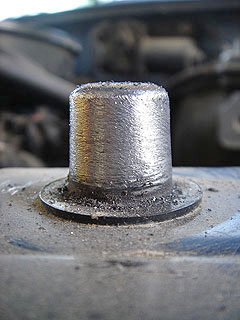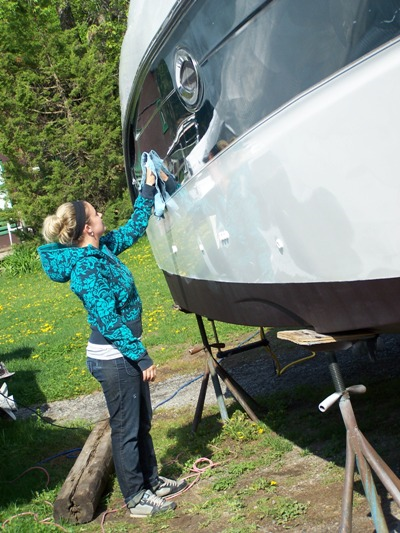
Awesome time of year, right? We are all a bit excited as spring approaches and we sense the first boat ride is around the corner. Is there anything more exhilarating than the maiden run in your pride and joy, or that new or used boat that you purchased over the winter and have been aching to get behind the wheel of? Bring on the Big Rideau Lake, Thousand Islands, or other gorgeous waterway....you are stoked to hit the water!
Well, not so fast. Let's try not to make the first voyage, or the start of your season, a bad one. Here are some common things that we all can easily overlook when eager to get out on the water.
- Missing or Defective Gear. Take any if those lines or fenders home for the winter? How about PFDs, or safety kit? Make sure you get everything back on board for the first run. The water in spring is super cold and if trouble hits, be prepared. It's a good time to check that your fire extinguisher(s) are up to charge, replace your flashlight batteries, and inspect all your life jackets too.
- Oils and Lubes not right. You changed your lower unit lubricant and engine oil in the fall right? Great! Hold on a second, even thought you did the right thing and stored your baby with the fresh stuff, who's to say it's still ok! Oils can leak out by drain pugs that are not tightened properly or maybe you have a leaky seal that gave up over the winter.
 Check the levels and check that excess moisture hasn't built up. When you "crack" the drain in your lower unit make sure the o-ring or gasket is there, and that water is not the first thing that drips out. When you check the engine oil, ensure that the level isn't too high or too low, and that there isn't extra moisture in the dipstick.
Check the levels and check that excess moisture hasn't built up. When you "crack" the drain in your lower unit make sure the o-ring or gasket is there, and that water is not the first thing that drips out. When you check the engine oil, ensure that the level isn't too high or too low, and that there isn't extra moisture in the dipstick. - Boat is not clean and waxed to start off. Once you launch, it is significantly harder to give your boat a good clean. If you don't do it now, you may not. Summers are busy and for fun, so at the very least make sure it is super clean in the spring. Wash it down with soap and water (including the canvas), wipe the seats, vacuum the carpets, and get rid of any junk in the storage compartments. If it is painted or fibreglass and gel coat, also make sure that it has a protective marine polish or wax to keep the sun's rays from doing damage. This task can be a bit time consuming, and yet rewards you by saving you time all season (the boat repels more dirt and stains with a good coat of wax), and with a higher resale value by not allowing your finish to fade/oxidize as easily. Clean your bottom in the fall, clean your top sides in the spring!
- Battery is neglected. Hopefully you stored your marine battery fully charged and disconnected from your boat's electrical system. When you put it back in, charge it first, if possible. Also, take a moment to clean all the terminals and connections with a wire brush. Corrosion
 builds up on them over the winter and this step will help your 12v system operate properly, get enough power for good clean starts, and allow it to be charged properly while underway. If you can access (service) your battery's cells, make sure they are full to the fill mark and top up if necessary with distilled water. Check the sides for bulges or cracks which may hint towards future issues. How old is that battery? If it is more than four seasons old, you may save yourself a lot of grief by swapping out out now.
builds up on them over the winter and this step will help your 12v system operate properly, get enough power for good clean starts, and allow it to be charged properly while underway. If you can access (service) your battery's cells, make sure they are full to the fill mark and top up if necessary with distilled water. Check the sides for bulges or cracks which may hint towards future issues. How old is that battery? If it is more than four seasons old, you may save yourself a lot of grief by swapping out out now. - Put a plug in it will ya! Your drain plug literally keeps you on the water, and not under it! Make sure that it is not cracked, and most importantly is in! How many are there? While you are at it, inspect your hull and underwater gear (prop, skew, rudder, etc.) as needed, and look over your hull for cracks, etc. also, if your engine is an inboard or inboard/outboard, make sure the engine drain plugs are snug and all hoses are tight! A loose hosemay make the first trip a short and expensive one!

- Assuming fuel stores well. Hopefully you stabilized the fuel that was left in your tank. If there is room to, add fresh low ethanol fuel as soon as possible. Use up what's in that tank as soon as is feasible and keep it fresh. If you launch in early May, go for a short run on the old fuel, part it at the dock, and then leave it there till late June, you are asking for trouble. Get fresh gas in and keep renewing it as much as you can.
- You didn't fix what was broken. Remember that issue you had last season, that part that was loose, or the electrical component that was intermittent? Maybe the engine was running rough, or a little hot. Whatever the issue was, it would have been an ideal time over the off season to have it fixed. Didn't take advantage of that? Don't start off with the same issues, get them repaired now before they get worse and cause you to lose a weekend, more money, or become unsafe.
7.5 Forgetting to communicate with your marina. This one's in case you store your boat at a marina and they are the ones who are in charge of all of the above. Tell them what you want, and don't be afraid to ask questions about what they do (or don't do). Spring at a good marina is and should be a busy place. They are often under very tight timeframes and sometimes don't have the best weather to accomplish them in. The most important part is to book your launch in plenty of time. Don't give them less than a week's notice, or just show up expecting it to be in the water and ready. Your boat is important to you both, so give them some time to take good care of it.
Do you have any other spring blunders that you have committed or know of? Share them here with us and we'll pass them on and smile along with you. Now that you have avoided all of those pitfalls, get out there and have an amazing first boat ride and incredible season!
Sean Horsfall sean@lenscove.com


